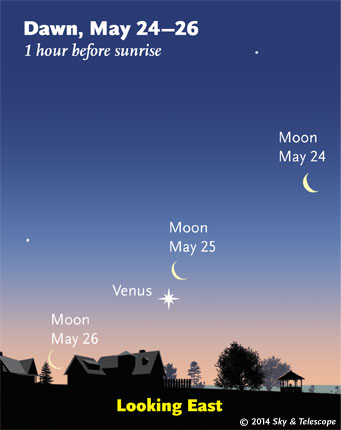
Friday, May 23
Meteor Update Saturday morning: Well that was a dud! Meteor watchers all over North America who went out in the early morning hours for the new predicted Camelopardalid shower saw few if any. People indeed reported observing a handful of meteors from the new radiant, but just a few per hour. Article.
Call it the Comet ISON of meteor showers.
New meteor shower? A strong meteor shower may arrive in the early-morning hours of Saturday, timed for North America — perhaps peaking around 3 a.m. EDT; midnight PDT. (The rest of the world is either in daylight or facing away from the incoming meteors.) For just a couple hours, we'll pass through the predicted debris trail of Comet 209P/LINEAR, which is making an unusually close flyby of Earth. There's even a (slim) possibility that the shower could approach "meteor storm" levels. A high proportion of the meteors may be bright. And as meteors go, they will move across the sky unusually slowly.
During dawn on Saturday morning the 24th, look for Venus well to the lower left of the waning crescent Moon, as shown above.
Saturday, May 24
Low in the dawn on Sunday the 25th for the Americas, Venus shines beautifully below the thin crescent Moon, as shown above. Look east.
Sunday, May 25
At dusk this evening, Mercury appears the same distance lower right of Jupiter and lower left of Capella.
Monday, May 26
Arcturus shines high in the southeast these nights. Vega shines much lower in the northeast. Look a third of the way from Arcturus to Vega for dim little Corona Borealis, the Northern Crown, with its one modestly bright star, Alphecca or Gemma. Two thirds of the way from Arcturus to Vega glimmers the dim Keystone of Hercules. Continue on down past Vega, and you hit Cygnus.
Tuesday, May 27
Comet 209P/LINEAR, the source of last Saturday morning's meteors, is closest to Earth for the next five days. It was only 13th magnitude as of May 22nd, but if you want to try for it with a large telescope, here are our finder charts. It's south of Leo, crossing Sextans and Crater.
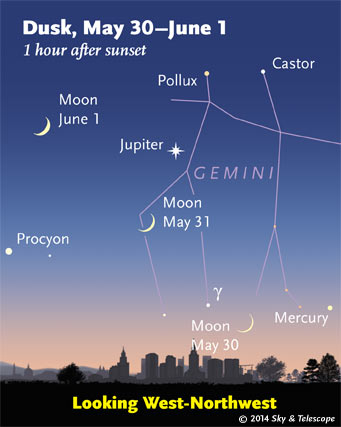
Wednesday, May 28
What is the oldest thing you have ever seen? The Earth, Sun, Moon, and planets are 4.6 billion years old. The age record for people who just glance at the sky might be Arcturus, about 7 billion years old.
But with a pair of binoculars, you can pick up the 7.2-magnitude star HD 140283 in Libra. This star is in competition for the title of the oldest known, with an age recently measured at about 13 billion years. That means it formed just several hundred million years after the Big Bang. Spot it using the finder chart with Gary Seronik's Binocular Highlight column in the June Sky & Telescope, page 45. This is almost certainly the oldest thing you will ever see.
New Moon today (exact at 2:40 p.m. EDT).
Thursday, May 29
As twilight turns to darkness, Mars shines brightly fire-colored in the south. Look below it for the four-star pattern of Corvus, the Crow.
Friday, May 30
Look very low in the west-northwest in twilight for the hairline crescent Moon with Mercury to its right. They're far to the lower right of bright Jupiter, as shown here. Binoculars will help.
Saturday, May 31
The Moon, Jupiter, and Pollux above them form a nearly straight line in twilight as seen from North America, as shown here.
Want to become a better astronomer? Learn your way around the constellations. They're the key to locating everything fainter and deeper to hunt with binoculars or a telescope.
This is an outdoor nature hobby. For an easy-to-use constellation guide covering the whole evening sky, use the big monthly map in the center of each issue of Sky & Telescope, the essential guide to astronomy. Or download our free Getting Started in Astronomy booklet (which only has bimonthly maps).

Once you get a telescope, to put it to good use you'll need a detailed, large-scale sky atlas (set of charts). The standards are the little Pocket Sky Atlas, which shows stars to magnitude 7.6; the larger and deeper Sky Atlas 2000.0 (stars to magnitude 8.5); and once you know your way around, the even larger Uranometria 2000.0 (stars to magnitude 9.75). And read how to use sky charts with a telescope.
You'll also want a good deep-sky guidebook, such as Sue French's Deep-Sky Wonders collection (which includes its own charts), Sky Atlas 2000.0 Companion by Strong and Sinnott, the bigger Night Sky Observer's Guide by Kepple and Sanner, or the beloved if dated Burnham's Celestial Handbook.
Can a computerized telescope replace charts? Not for beginners, I don't think, and not on mounts and tripods that are less than top-quality mechanically (able to point with better than 0.2° repeatability, which means fairly heavy and expensive). As Terence Dickinson and Alan Dyer say in their Backyard Astronomer's Guide, "A full appreciation of the universe cannot come without developing the skills to find things in the sky and understanding how the sky works. This knowledge comes only by spending time under the stars with star maps in hand."
This Week's Planet Roundup
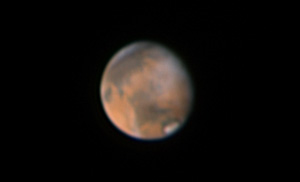
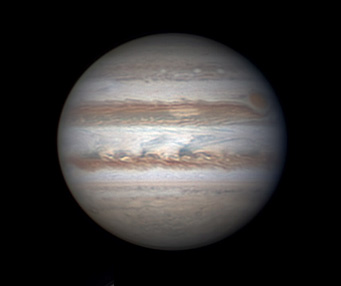
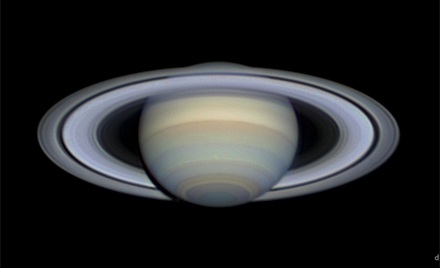
Venus (magnitude –4.0) is the "Morning Star" low due east during dawn. How late into the brightening daylight can you follow it?
Mars (magnitude –0.7, in Virgo) shines highest in the south in late twilight. Just left or upper left of it 3rd-magnitude Porrima. Far lower left of Mars sparkles Spica. Mars sets in the west around 3 or 4 a.m. daylight saving time.
In a telescope, Mars's gibbous disk is now 12 arcseconds tall, and shrinking as we leave Mars farther behind in our faster orbit around the Sun. See the Mars map and observing guide in the March Sky & Telescope, page 50. Use our Mars Profiler to find which side of the planet will be facing Earth when you plan to look.
Jupiter (magnitude –1.9, in Gemini) shines brightly in the west in twilight, lower left of Pollux and Castor. It sinks during the evening and sets around 11 or midnight. Jupiter is on the far side of the Sun from us; in a telescope it has shrunk to 33″ across its equator, nearly its minimum apparent size.
Saturn (magnitude +0.1, in Libra) is two weeks past 10th opposition. It shines in the southeast during evening and stands highest in the south around 11 or midnight. Look for Antares and the head of Scorpius well to its lower left.
It a telescope Saturn's globe is 19″ wide, and its rings are tilted a nice 22° from our line of sight. Use our SaturnMoons app to find and identify Saturn's various satellites at any time and date.
Uranus, in Pisces, is very low in the east just before dawn.
Neptune, in Aquarius, is up in the southeast before the first light of dawn. Finder charts for Uranus and Neptune in 2014.
“This adventure is made possible by generations of searchers strictly adhering to a simple set of rules. Test ideas by experiments and observations. Build on those ideas that pass the test. Reject the ones that fail. Follow the evidence wherever it leads, and question everything. Accept these terms, and the cosmos is yours.”
— Neil deGrasse Tyson, 2014. Only two episodes of the Cosmos series remain to air: on Sunday nights on Fox and Mondays on National Geographic (the final episode airs June 1 and 2). Watch recent episodes online anytime.
All descriptions that relate to your horizon — including the words up, down, right, and left — are written for the world's mid-northern latitudes. Descriptions that also depend on longitude (mainly Moon positions) are for North America.
Eastern Daylight Time (EDT) is Universal Time (UT, UTC, or GMT) minus 4 hours.
 0
0








Comments
You must be logged in to post a comment.